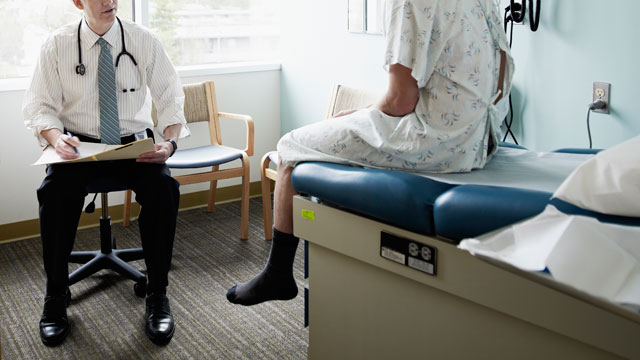Many men with testicular cancer have no known risk factors. And some of the known risk factors, such as undescended testicles, white race, and a family history of the disease can’t be changed. For these reasons, it is not possible now to prevent most cases of this disease.
Experts recommend correcting cryptochidism in boys for a number of reasons (such as preserving fertility and body image), but it’s not clear how much this changes the child’s risk for testicular cancer.
What are the Risk Factors for Testicular Cancer?
A risk factor is anything that changes your chance of getting a disease such as cancer. Different cancers have different risk factors. Some risk factors, like smoking, can be changed. Others, like a person’s age or family history, can’t be changed.
But having a risk factor, or even several, does not mean that you will get the disease. Just as having no risk factors doesn’t mean you won’t get the disease. And some people who get the disease may not have had any known risk factors. Even if a person with testicular cancer has a risk factor, it’s often very hard to know how much that risk factor contributed to the cancer.
Scientists have found few risk factors that make someone more likely to develop testicular cancer. Even if someone has one or more risk factors for this disease, it’s impossible to know for sure how much the risk factor contributes to developing the cancer. Also, most boys and men with testicular cancer do not have any of the known risk factors. Risk factors for testicular cancer include:
- An undescended testicle
- Family history of testicular cancer
- HIV infection
- Carcinoma in situ of the testicle
- Having had testicular cancer before
- Being of a certain race/ethnicity
- Body size
Undescended Testicle
One of the main risk factors for testicular cancer is a condition called cryptochidism, or undescended testicle(s). This means that one or both testicles fail to move from the abdomen (belly) into the scrotum before birth. Males with cryptochidism are several times more likely to get testicular cancer than those with normally descended testicles.
Normally, the testicles develop inside the abdomen of the fetus and they go down (descend) into the scrotum before birth. In about 3% of boys, however, the testicles do not make it all the way down before the child is not born. Sometimes the testicle remains in the abdomen. In other cases, the testicle starts to descend but remains stuck in the groin area.
Most of the time, undescended testicles continue moving down into the scrotum during the child’s first year of life. If the testicle has not descended by the time a child is a year old, it probably won’t go down on its own. Sometimes a surgical procedure known as orchiopexy is needed to bring the testicle down into the scrotum.
The risk of testicular cancer might be a little higher for men whose testicle stayed in the abdomen as opposed to one that has descended at least partway. If cancer does develop, it is usually in the undescended testicle, but about 1 out of 4 cases occur in the normally descended testicle. Because of this, some doctors conclude that cryptochidism doesn’t actually cause testicular cancer but that there is something else that leads to both testicular cancer and abnormal positioning of one or both testicles.
Orchiopexy may reduce the risk of testicular cancer if it done when a child is younger, but it is not clear if it is helpful if the child is older. The best time to do this surgery is not clear. Experts in the United States recommend that orchipexy be done soon after the child’s first birthday for reasons (such as fertility) that are not related to cancer.
Family History
Having a close blood relative (father 0r brother) with testicular cancer increases the risk that you will get it, too. But only a small number of testicular cancers occur in families. Most men with testicular cancer do not have a family history of the disease.
HIV Infection
Some evidence has shown that men infected with the human immunodeficiency virus (HIV), particularly those with AIDS, are at increased risk. No other infections have been shown to increase testicular cancer risk.
Carcinoma In Situ
This condition often doesn’t cause a lump in the testicles or any other symptoms. It isn’t clear how often carcinoma in situ (CIS) in the testicle progresses to cancer. In some cases, CIS is found in men who have a testicular biopsy to evaluate infertility or have a testicle removed because of cryptochidism. Doctors in Europe are more likely than the doctors in this country to look for CIS. This may be why the numbers for diagnosis and proression of CIS to cancer are lower in the United States than in parts of Europe.
Cancer in the Other Testicle
A personal history of testicular cancer is another risk factor. About 3% or 4% of men who have been cured of cancer in one testicle will eventually develop cancer in the other testicle.
Age
About half of testicular cancers occur in men between the ages of 20 and 34. But this cancer can affect males of any age, including infants and elderly men.
Race and Ethnicity
The risk of testicular cancer among white men is about 4 to 5 times that of black men and that of Asian-American men. The risk of American Indians falls between that of Asians and whites. The reason for these differences is not known. Worldwide, the risk of developing this disease is highest among men living in the United States and Europe and lowest among men living in Africa or Asia.
Body Size
Several studies have found that tall men have a somewhat higher risk of testicular cancer, but some other studies have not. Most studies have not found a link between testicular cancer and body weight.
Unproven or Controversial Risk Factors
Prior injury or trauma to the testicles and recurrent actions such as horseback riding do not appear to be related to the development of testicular cancer.
Most studies have not found that strenuous physical activity increases testicular cancer risk. Being physically active has been linked with a lower risk of several other forms of cancer as well as a lower risk of many other health problems.
Do We Know What Causes Testicular Cancer?
The exact cause of most testicular cancers is not known. But scientists have found that the disease is linked with a number of other conditions, which are described in the risk factors mentioned above. A great deal of research is being done to learn more about the causes.
Researches are learning how certain changes in a cell’s DNA can cause the cell to become cancerous. DNA is the chemical in each of our cells that makes up our genes. Genes tell our cells how to function. They are packaged in chromosomes, which are long strands of DNA in each cell. Most cells in the body have 2 sets of 23 chromosomes (one set of chromosomes comes from each parent), but each sperm or egg cell has only 23 chromosomes. When the sperm and egg combine, the resulting embryo has a normal number of chromosomes in each cell, half of which are from each parent. We usually look like our parents because they are the source of our DNA. But DNA affects more than how we look.
Some genes control when our cells grow, divide into new cells, and die. Certain genes that help cells grow and divide are called oncogenes. Others that slow down cell division or make cells die at the right time are called tumor suppressor genes. Cancers can be caused by changes in chromosomes that turn on oncogenes or turn off tumor suppressor genes.
Most testicular cancer cells have extra copies of a part of chromosome 12 (called isochromosome 12p or i12p). Some testicular cancers have changes in other chromosomes as well, or even abnormal numbers of chromosomes (often too many). Scientists are studying these DNA and chromosome changes to learn more about which genes are affected and how this might lead to testicular cancer.

